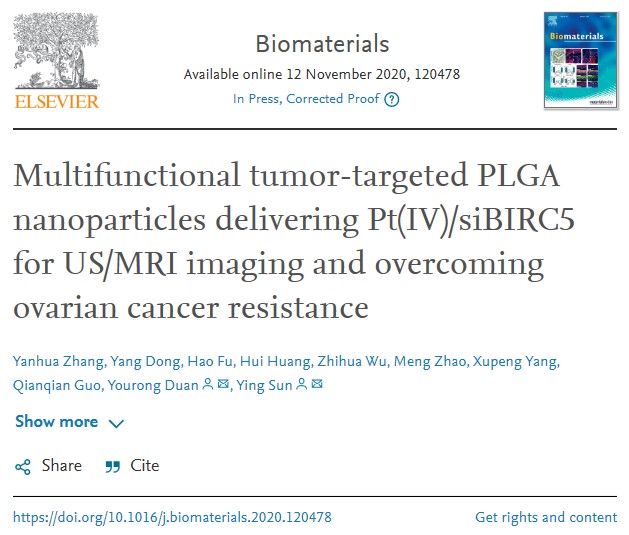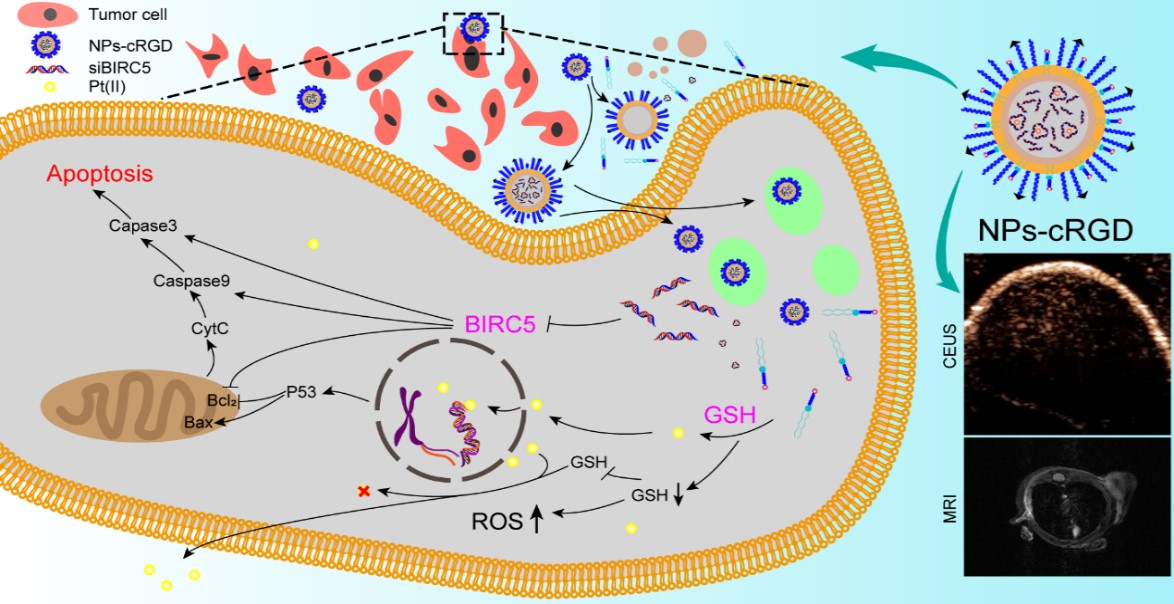
Research Progress
Sun Ying and Duan Yourong research team from SCI released the research on multifunctional PLGA nanoparticles delivering Pt(IV)/siBIRC5 for US/MRI imaging and overcoming ovarian cancer resistance in Biomaterials
日期:2021-01-08
Recently, the research team led by Sun Ying and Duan Yourong from Shanghai Cancer Institute (SCI) published a research paper with the title of “Multifunctional tumor-targeted PLGA nanoparticles delivering Pt(IV)/siBIRC5 for US/MRI imaging and overcoming ovarian cancer resistance” in the internationally renowned journal of Biomaterials online, which was funded by National Natural Science Foundation of China. The paper was completed by the first author Zhang Yanhua, a master student graduating in 2020 with the guidance of Sun Ying, an associate researcher and Duan Yourong, a researcher. In this study, the classic biomaterial poly (lactic-co-glycolic acid) (PLGA) delivering platinum (IV) [Pt(IV)]/small interfering baculoviral IAP repeat containing 5 (siBIRC5) was applied for the drug/gene synergistic combination, thereby overcoming ovarian cancer resistance, and the nanosystem could achieve the integration of diagnosis and treatment for its multi-modal imaging function .

Cisplatin [Pt(II)] resistance is a major problem to be resolved urgently in the clinical chemotherapy of ovarian cancer. Studies have found that Pt(II) resistance in ovarian cancer has an association with high glutathione (GSH) content and high expression of anti-apoptotic gene BIRC5. As such, multifunctional tumor-targeted PLGA nanoparticles (NPs-cRGD) were designed and developed by the team of Sun Ying and Duan Yourong using the classic biomaterial PLGA. Uniformly sized NPs-cRGD demonstrated excellent drug and gene loading and gene protection capacities and good stability. Meanwhile, such a nanoparticle has ultrasound (US)-responsive drug-gene burst release property, thereby helping increase local tumor drug-gene concentrations and achieving targeted drug delivery in vivo. The in vitro study demonstrated that ultrasound facilitated the absorption of NPs-cRGD by cells, and NPs-cRGD escaped from lysosomes successfully. On the one hand, Pt (IV) was reduced to Pt (II) by means of a high concentration of GSH in cells, and Pt (II) bound to DNAs and inhibited gene expressions, thereby up-regulating p53 expression to induce the mitochondrial apoptosis pathway, while the exhaustion of GSH and production of Pt (II) jointly promoted the increase in reactive oxygen species levels, thereby killing cells. On the other hand, NPs-cRGD escaped from lysosomes to prevent the interfering gene siBIRC5 from nuclease degradation and overcome the antiapoptotic effect, ultimately conquering cell resistance with the drug. NPs-cRGD showed excellent tumor-targeting, low toxicity and properties of US imaging and magnetic resonance imaging (MRI) in vivo. Collectively, the research team ingeniously designed and prepared an intelligent US-responsive drug-gene carrier NPs-cRGD delivering Pt(IV)/siBIRC5 on the basis of the cellular properties to overcome ovarian cancer resistance by the drug-gene synergistic combination. The carrier also integrated multi-modal imaging function to combine the diagnosis and treatment, thereby providing a new strategy for the treatment of drug resistance in ovarian cancer.
